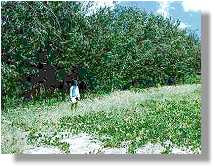Name
Casuarinas are distinctive in the Australian landscape, particularly along
the beaches of Magnetic Island. The name Casuarina is derived from
the Malay Kasuari, resembling the drooping foliage of the genus
and that of the feathers of a cassowary bird. The genus Casuarina
has approximately 56 species. The beach she-oak, Casuarina equisetilolia
occurs within the Nelly Bay Habitat Reserve.
 Casuarina woodland
Casuarina woodland
Click to enlarge |
Characteristics
The Casuarina foliage is made up of jointed photosynthetic branchlets
that have grooves running along the length, where the stomata are located.
The ridges between the grooves terminate in leaf tips, collectively forming
many minute leaves at the joint. The photosynthetic branchlets of Casuarina
equisetilolia are distinctively long and weeping.
Many species of Casuarina occur in early ecological succession of new
sites and are therefore light demanders and can occupy a wide range of
habitat types. The wood of most Casuarinas is dense and very hard. The
wood is considered to be an excellent fuel and when burnt, the wood will
produce high amounts of heat with relatively minimal smoke. Casuarina
equisetilolia is considered by some the best fuel wood species in
the world. The bark from Casuarina equisetilolia is used in tanning,
in medicine and for the extraction of dyes. Several species of Casuarina
are planted as shade trees in parks, for beach stabilisation after mining
activities and on mining spoil dumps.
At Nelly Bay Habitat Reserve
The Casuarina woodland is almost a pure stand of Casuarina or mixtures
of strand vegetation such as Barringtonia asiatica, Terminalia
spp. Thespesia populnea with a variety of grasses, forbs and sedges.
Much of this vegetation type is found only as a very narrow strip along
the sandy coastline.
|